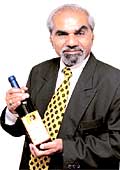|
It
inspired Omar Khayyam to pen his immortal Rubaiyat. Emperor Jehangir
was reportedly willing to trade his empire in return for his daily
fix of the stuff. And Indians are only now beginning to realise
why. Urban India's drinking habits are evolving. Slowly! A significant
minority has already had its first tryst with wine. And many of
them enjoyed the experience. Result: a minor explosion in demand,
the so-called first wave of demand for wine.
Ask Champagne Indage head honcho S.G. Chougule
about the potential of the Indian wine market, and he says: "Sky
is the limit." Champagne Indage is the country's largest
wine producer and seller, and accounts for an overwhelming 70
per cent of domestic production. The numbers are still small-Rs
200 crore (6.35 lakh cases) per annum of domestic production and
another Rs 100 crore (1.4 lakh cases) of imported wines-but they're
growing at a more than healthy 30 per cent per year. The per capita
consumption: 10 ml per year. If that sounds like a dose or two
of cough syrup, sample this: the per capita consumption of wine
in the US is 8 litres. In France and the UK, the comparable figures
are 60 litres and 25 litres, respectively. "If good wines
are not available, how will the market grow?" asks Abhay
Kewadkar, Vice President, Grover Vineyards.
In this context, vintners are excited by
Union Agriculture Minister Sharad Pawar's proposal that wine be
sold as freely as soft drinks. If implemented, this will change
the dynamics of the wine trade. Sula Vineyards Managing Director
Rajeev Samant points out that wine is sold in supermarkets across
the world. "And it is already sold in supermarkets in cities
like Bangalore, Delhi and Chandigarh. Why should Mumbai, and the
rest of the country, be exceptions?" he asks.
CHEERS
All you wanted to know about the Indian
wine industry |
The Vital Stats
Size: 7,75,000 cases
Value: Rs 300 crore
Growth Rate: 30 per cent
All figures for 2004-05; includes both domestic and imported
wines; 1 case = 12 bottles
Categories of Wines Available in
India
Rs 250: Goan wine, Golconda and Bosca.
Rs 250-700: Indage, Grover, Sula and Vinsura
RRs 700+: Imported wines like Michele Laroche, Albert
Bichot, Vina Montes and Two Orphans, Turning Leaf, Carlo
Rossi and Gallo
Sign Language
MII: Made in India
BII: Bottled in India
BIO: Bottled in Origin
|
But that's just the distribution angle. What
about upstream issues? Do the three largest domestic players-Indage,
Sula and Grover Vineyards-have scalable operations?
Indage does, says Chougule. He predicts that
the domestic wine industry will grow to Rs 500 crore by 2010.
To cater to this growing demand, his company is expanding beyond
its base in Maharashtra, which accounts for over 70 per cent of
the country's wine production. "We will be setting up two
wineries in Himachal Pradesh and one each in Andhra Pradesh, Tamil
Nadu, Karnataka and West Bengal. While the one in West Bengal
will be ready in the next six months, the winery in Himachal Pradesh
will be ready next year," he informs. Those in Karnataka
and Andhra Pradesh will be up in 2007, while the one in Tamil
Nadu will start once the quality of wine is approved. The investment:
Rs 40 crore. On completion of this phase of expansion, Indage's
capacity will rise from six million litres a year now to 12 million
litres a year, and take its group turnover from Rs 140 crore to
Rs 300 crore. Sula Vineyards, which has about 300 acres of vineyards
(of this, 200 acres are planted), is increasing its acreage to
600 acres. This will take Sula's output of wine grapes from 700
tonnes last year to 1,500 tonnes this year and increase sales
from 70,000 cases to 1.4 lakh cases. Grover, meanwhile, will increase
its acreage from 300 acres this year to 400 in 2006, allowing
it to raise its production from 90,000 cases to 1.25 lakh cases.
Chougule adds that 38 wineries have come up in India over the
last five years.
Clearly, there's a large wine story panning
out, with every player looking to grab a bigger piece of the action.
But it's not a very easy industry to operate in-one requires high
degrees of patience, perseverance and skill to survive. It also
requires a fair amount of luck for a grape crop to produce a good
yield; and the break-even period could stretch to 10 years. According
to Kewadkar, Grover took about 8-10 years before it began earning
money. During this phase, it had to recruit and retain high-cost
skilled manpower to ensure a good quality crop. "You will
need microbiologists and food processors. The barriers to entry
can be huge," says Samant.
 |
| Sula's Vineyards' Samant: Wine should
be sold freely |
The other issue is the availability of wine
grapes- as opposed to the more popular table grapes that people
consume as a fruit-but the wine industry does not consider this
an insurmountable problem. "Table grapes give the farmer
Rs 10 per kg, while the wine grape gives him Rs 25-35 per kg,"
says Kewadkar, adding that long-term contracts between companies
such as his and grape farmers "are a win-win situation for
both since we get assured supplies for 10-15 years and the farmer
factors out price and demand fluctuations from his equation."
Farmers and wine manufacturers typically
enter into cultivation agreements for a certain number of years.
Sula, for instance, owns the land and enters into cultivation
agreements with farmers, who get about Rs 30 per kg of wine grapes.
Farmer's investment: Rs 30,000. With yields varying from 4-6 tonnes
per acre, a farmer cultivating one acre stands to earn a decent
amount for his labours. Today, wine manufacturers are looking
to create tripartite arrangements with banks and farmers. Here,
the manufacturer stands guarantee for the money that the farmer
borrows to meet his initial investment. This, obviously, works
to the advantage of both the farmer as well as the wine manufacturer.
All the three players own vineyards-Indage and Sula have land
in Maharashtra, while Grover is based in Karnataka.
 |
| Indage's Chougule: Thinks demand will
explode |
That Indian vintners are coming of age is
evident from the fact that their products are being accepted abroad.
The three largest players together exported 1 lakh cases worth
approximately Rs 15 crore last year to Europe, the us and Asia.
Sula's Sauvignon Blanc sells in France at euro 13 (Rs 702) a bottle.
Indage's Marquise de Pompadour, a sparkling wine, sells as Omar
Khayyam in the export markets, while its better-known brand Riviera
goes as Chhabri. These are sold in 44 countries, including the
UK, Germany, France, Switzerland and the US. While Omar Khayyam
is priced at about £14 (Rs 1,100), Chhabri costs £5
(Rs 395). Grover, too, is pretty optimistic about its export prospects.
"We export 30 per cent of our production to countries like
France, the US and the UK," says Kewadkar. Indage, in fact,
has a dedicated vineyard to cater to the export market, despite
its primary focus on the domestic one. "The export market
is very competitive. Consequently, the domestic market is more
profitable," adds Chougule.
Foreign players are also homing in on this
growing market. Some of them import wine into India in bulk and
bottle it here, while some others simply import and sell bottled
wine. Says Sanjay Menon, Managing Director of wine importer Sansula:
"The imported wine market accounts for about 1.4 lakh cases
each year and is valued at Rs 100 crore." The company imports
and distributes wines such as Michele Laroche and Nederberg, which
cost upwards of Rs 750 a bottle and cater to the top end of the
market. This segment is growing at 20 per cent per annum.
 |
| Grover Vineyards' Kewadkar: MNCs will
grow the market |
Beer major Foster's, which sells its eponymous
brand of Australian beer in India, is also eyeing this market.
Says Foster's India Managing Director Pradeep Gidwani: "There
is a nascent opportunity in the Indian wine market; and the Foster's
Group is evaluating the opportunities that exist here." The
company owns such global best sellers as Wolf Blass, Lindermans
and Beringer.
The imminent entry of foreign players doesn't
worry Indian vintners. On the contrary, they welcome the development.
"It is important for more players to come in. This will increase
awareness and, in turn, expand the market," says Kewadkar.
Pushing consumption is a combination of dropping
prices-a good bottle of Indian wine costs about Rs 400-500, about
the same as a bottle of premium Indian whisky or vodka-higher
disposable incomes and greater awareness about international lifestyles
across the country. But Kewadkar says it will take at least another
3-5 years for wine to become a part of daily life outside of the
metros and the bigger cities. But when that happens-and if Sharad
Pawar can push his proposal through-there will be an explosion
in demand.
Cheers to that.
|







